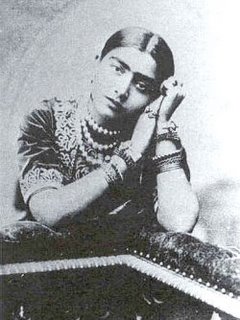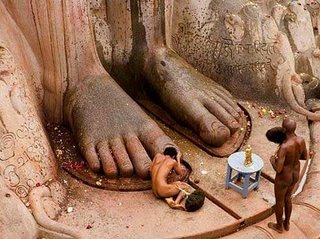
"The length of a film should be directly related to the endurance of the human bladder." ~Alfred Hitchcock
The idea of Do Bigha Zameen came to Bimal Roy, they say, when he was sitting at the top of a double-decker bus on his way home from a screening of Vittorio De Sica’s classic, Bicycle Thief, based novel by Luigi Bartolini. And that was 56 years ago.
Everyone’s got their knickers in such a twist about a supposed trend in Hindi films to go back to literature for story ideas. Look at Parineeta and Devdas and Maqbool and Paheli and Sarkar and 1918 Banaras A Love Story and ……they reel off breathlessly. (If you don’t know which novels those films were based on, you don’t need to read this article anyway!) And now Vishal Bharadwaj is bringing up the rear by the second of his Shakespeare based trilogy with Omkara, which is based on Othello. And “inspired” by aapro Sanjay, there are a whole rash of remakes threatening to crop up. Sahib Biwi Aur Ghulam and Umrao Jaan and what not. Everyone’s in such a tizzy, such a dither, such a lather. Why, oh, why, they agonize, wringing their hands worriedly and knitting their brows into a fine Fair Isle, is this happening? Is this because there are very few original scriptwriters around in the Hindi film industry? (How many were there in the first place, is my naive question.) Is it because there is a paucity of ideas? (Was there ever a plethora, I timidly suggest.) Though no one has yet asked perhaps what is the more pertinent question - are the video libraries on strike and so everyone running low on their supply of Hollywood films to…er, be inspired by?
Never mind. But even if it is indeed true that droves of directors in apun ka Hindi phillum industry are enthusiastically diving into their Complete Works of Munshi Premchand and blowing the dust off their Remaker’s Guide to Sarat Chandra (who else) and de-cob webbing their How-to-narrate-Shakespeare-in-One-Liners (would Ram Teri Ganga Gayi be a good title for a “remake” of Romeo and Juliet, I wonder), it might put things a little into perspective if we remember how it all began …..
On 21st April 1913, India’s first full-length feature film, Dada Saheb Phalke's Raja Harishchandra was commercially screened. Phalke’s subsequent films – totally around 100 in number - were films like Mohini Bhasmasur, Satyavan Savitri, Shri Krishna Janam, Bhakt Prahlad and India’s first box office hit, Lanka Dahan. Baburao Painter's first film in 1920 was Sairandhri (one of Draupadi’s names) and his subsequent films were Sati Padmini, Shri Krishna Avtaar, Vatsalaharan, Surekha Haran etc. The first South Indian feature film was R. Nataraja Mudaliar's Gopal Krishna. The first Marathi film – and a huge hit – was V. Shantaram’s Ayodhyacha Raja and the first Oriya film was Sita Bibaha. And so on and so forth.
Yeah, yeah, we know all this, but what’s my point? Just this. It’s plain as pie that the first 15-20 years of Indian cinema happily and voraciously fed off two of the world’s greatest pieces of literature, the Ramayana and the Mahabharata. Even when Indian filmmakers found their filmmaking legs and looked for other story sources, the obvious choice was the vast and rich treasury of Indian literature, both ancient and modern. Baburao Painter's 1925 classic, Savkari Pash (in which V. Shantaram made his debut as an actor) was a film adaptation of the novel written by the man who is considred the founder of the modern Marathi novel - Hari Narayan Apte.
And almost 20 years after Raja Harishchnadra, when Ardeshir Irani made India’s first talkie, Alam Ara, in 1931, it was based on a Parsi play written by Joseph David. In 1937, V. Shantaram took another of Apte’s novels, Na Patnari Ghosta and made into not one but two masterpieces – first in Marathi as Kunku and then as Duniya Na Mane in Hindi, both in 1937. His Shakuntala in 1943, based on Kalidasa’s great play, ran for an incredible 104 weeks Apart from Sikander, Sohrab Modi’s and Prithviraj Kapoor’s other great collaboration, Prithvi Vallabh also in 1943 was based on Kanhayalal M. Munshi’s Gujarati novel by the same name. And of course, there was Vijay Bhatt’s Ram Rajya (1947).
And this trend to look to literature for stories continued. If you look at the 13 most memorable films that Bimal Roy made between 1945 and 1963, as many as 5 were born of Bengali literature – Bandini (based on Bengali writer Jarasandha’s novel, Tamasi), Kabuliwala (based on Tagore’s short story which Roy produced), Parineeta and Biraj Bahu, both based on novels by Sarat Chandra Chatterjee. I know. That adds up to only 4 but before I mention the 5th, I have to talk about dear ol’ Sarat. From the looks of it, he was Indian cinema’s most popular source for stories. And 68 years after his death, it seems that he still is! At least 41 films have been made of his novels and short stories. And among the more well-know - apart from Bimal Roy’s Parineeta and Biraj Bahu - are P. C. Barua’s Manzil, K L Saigal’s hit film, Pujarin in which he sang the ultimate tipplers’ anthem, Piye ja aur piye ja, said to be the only film song in Indian cinema that was recorded without any rehearsal or any set music! Then in more recent times, Basu Chatterjee’s Swami (1977) and Gulzar’s Khusboo (1975).
Am I not going to mention Devdas, at all, you ask, outraged?
Oh alright then. And Devdas. Which is the 5th Bimal Roy film based on Bengali literature. Since the novel was published 89 years ago (a full 16 years after Sarat Chandra wrote it!), it has been made into film at least 9 times, twice in Telugu including the super hit Devadasu, starring the superstar Akkeni Nageshwara Rao, which was made 2 years before Bimal Roy’s 1953 version. And a Tamil version of P C Barua’s Devdas was released simultaneously in which Saigal sang 2 songs….in Tamil!
So, in the almost hundred-year history of Indian cinema, Indian literature always fired the imagination of our filmmakers, resulting in some of our finest films – Satyajit Ray’s Shatranj Ke Khiladi (based on Mushi Premchand’s novel), Vijay Anand’s Guide (R. K. Narayanan), Basu Bhattacharya’s Teersi Kasam (Phaneshwarnath Renu), Abrar Alvi’s Sahib Biwi Aur Ghulam (Bimal Mitra), M. S. Sathyu’s Garam Hawa (Ismat Chugtai) just to name a few. And that’s not something unique about Indian cinema, but also a world wide phenomenon. From the Bible to Ernest Hemingway, from William Shakespeare to William Faulkner, from Charles Dickens to Arthur Miller, from Agatha Christie to Ian Fleming, all inspired both classics and blockbuster hits. And just look at some of the Oscars winners of the last 3 years - Brokeback Mountain, Million Dollar Baby, Harry Potter, Lord of The Rings, A Beautiful Mind. They all came out of short stories and novels.
And it is only but natural. Story telling is as old as man himself, not just an art form, but an instinct as primeval and compelling as hunger because in our stories, we record the history of our souls and our hearts. And cinema, storytelling’s youngest, most beguiling, most enchanting child has always looked to its elder sibling for inspiration,
So, is it a good thing or a bad thing that we are going back to books? Well, I’d say it’s a good because it means that our filmmakers are finally beginning to read. But, at the end of the day, it doesn’t really matter what a great film comes out of. The heart of great storytelling whether that’s around the fire, on your grandmother’s lap or in 70 mm technicolour is a cracking good story. Stuff that widens your eyes with wonder and shine with delight, makes your heart sigh and sing, makes you cry and laugh; stuff that transports you out of yourself to back inside again. And most importantly, that rivets you, involves you so completely that you forget everything but the burning question, “Phir kya hua?” And that magic could come out of a great piece of literature or a little news item tucked away in yesterday’s newspaper. “Woman with cellphone steals new born baby from maternity ward…”
Willa Cather, the great American novelist once famously said, “There are only two or three human stories, and they go on repeating themselves as fiercely as if they had never happened before.” And that would roughly sum up the task of any filmmaker – to take a story and tell it as magically if it has never been told before. Be that Devdas. Or Biwi No. 1.
[Hindi+Movies]
******
Did you know…
That the 1938 Tamil film that launched M. S. Subbulakshmi to cinematic fame was "Seva Sadanam,", was based on a Munshi Premchand's very first novel, Seva Sadan?
http://i90.photobucket.com/albums/k248/rajaiah/pear1.gif








